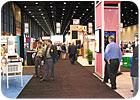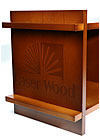
Because of their characteristic low heat, rapid curing and environmental benefits, ultraviolet (UV) and electron-beam (EB) technologies - collectively referred to as “radiation-curable” or “radcure” technologies - have become well-established in certain markets like graphic arts, printing, adhesive curing and the manufacture of products like CDs, optical fiber, headlight lenses and eyeglasses. UV is often the technology of choice where extreme clarity, durability or scratch resistance are necessary, but it’s also finding use in new applications such as soft-touch, flexible and multicolored coatings on metal, wood and plastics.
These and other trends were highlighted at the RadTech 2008 technical conference and exhibition, held May 4-7 in Chicago, IL. More than 2,200 attendees gathered in Chicago’s McCormick Place to learn about advances in UV and EB raw materials, formulations, equipment and processing, both from the technical program and from the 116 suppliers on the exhibit floor. Following are some of the highlights of the event.
Expanding Applications
The benefits of radiation-curable technologies have led to some new applications in food packaging, military and aerospace, many of which were discussed at RadTech 2008.Food Packaging.Consumers have shown a demonstrated preference for high resolution, bright, shiny graphics when picking products from store shelves. While UV is the ideal technology for producing these images, there has been a question about the safety of food contact with UV-cured packaging. To address this issue, a subgroup of more than 30 RadTech members banded together in a three-year effort to prove the safety of the technology.
On March 8, 2008, the RadTech Food Contact Alliance, comprising such companies as Alcan Packaging (Alcoa), Ashland Specialty Chemical, Bayer Polymers, Coatings and Adhesives Corp., Cytec Industries, Fusion UV Systems, Nordson, PPG Industries and Valspar, received clearance from the U.S. Food and Drug Administration (FDA) for direct food contact for several UV-curable materials. The UV- or EB-cured formulations can be used as coatings, including inks, or as components of coatings and inks on popular plastic, paper and cardboard packaging materials.
This is the first FDA clearance of a range of UV/EB curing materials for direct food contact, and it is expected to open new applications for UV and EB curing that previously might have been limited by a lack of explicit food-contact clearance. Under FDA regulations, only the alliance members and their customers may claim clearance for materials and formulations.
Military and Aerospace.UV and EB curing technologies recently have become a popular alternative in the aerospace, defense and homeland security markets. RadTech organized a full session to discuss a host of applications in these fields. The session included a paper on munitions identification coatings by Georgette Nelson of Concurrent Technologies Corp., and an update on the U.S. Air Force’s UV coatings program by Tom Naguy of the Air Force and Randy Straw of Concurrent Technologies Corp. Corey Bliss of the Air Force Research Laboratory presented information on UV-curable F-16 stencil coatings, and Chris Geib detailed new work on UV powder coatings for aerospace and defense applications being done with UV Robotics and Fusion UV.
The technical presentations were followed by an engaging panel discussion featuring representatives from the US Air Force, Navy and Army.

Cleveland, OH-based DVUV was presented with an innovation award for LaserWood application of UV-cured powder coatings on laser-embossed MDF substrates.
Innovation Awards
Eight companies were honored at a special awards ceremony and dinner for pioneering the commercial use of UV and EB technologies in their products.Automotive Use of UV.Both Ford and General Motors were acknowledged for their use of UV. At Ford, Mark Nichols and Chris Seubert are leading an effort to develop UV curing as an end-of-line repair process for Ford assembly plants. The process would provide rapid repair at a point in the line where bottlenecks can be a major problem.
At General Motors, UV is proving its value on the plant floor - literally. The General Motors Mansfield, OH stamping plant turns coiled steel into fenders, roofs and car doors in a 2.5 million ft2 facility. Shutting down sections of the facility to wait for a floor coating to dry is impossible. Dan Sullivan, the facility manager for the Mansfield plant, challenged Quaker Chemical’s Chemical Management Service Business to find a solution. In April 2006, the first UV-curable floor coating was trialed at the GM Mansfield facility, and it’s been full steam ahead ever since. The result is the first wide-scale adoption of UV-curable floor coatings by a major manufacturing company.
Flooring Applications.Prefinished wood flooring has become increasingly popular with consumers. It can be easily installed and is ready to use without the additional coating step. Additionally, it has higher durability due to the highly crosslinked nature of the coating, allowing suppliers to offer 10- to 25-year warranties. 3M and its customer, Mohawk Industries, teamed up to develop a new UV-cured Scotchgard protective technology for their flooring. The new wood flooring has unprecedented stain, soil and mar resistance without any adverse effects on the floor’s durability or appearance. Carl Cothran of Mohawk Industries was honored for his work on this project.
Jeffrey S. Ross, general manager, Quality, Innovation and New Product Development at Armstrong World Industries, Inc., also was acknowledged for his role in Armstrong’s continued expansion of UV/EB-cured coatings for hard-surface flooring. Armstrong has the reputation of being one of the earliest adopters of environmentally friendly and energy-efficient UV curing processing. Since 1973 when it launched a coated “no wax” tile, Armstrong has expanded the use of UV technology to five of its North American plants. Building on this success, Armstrong has executed a multiplant project to migrate from solvent-based coatings systems to water-based or 100%-solids coatings systems. Armstrong presented two technical papers at the event focused on “green” and “greener” technology, including the use of biomass products.
UV Taking Flight.Reducing the “dry-to-fly time” can be a critical issue for the military. At this time, the United States Air Force (USAF) most commonly uses coating systems that require a minimum of 72 hours of cure time before an aircraft can be flown. This cure time also applies to the coatings used for stencils and markings that are applied over the topcoat. In a military/corporate partnership that included Bayer MaterialScience, H&S Autoshot and Deft, a UV-curable coating for markings was been developed that adheres to military specification topcoats, and fully cures in minutes. In a first-of-its-kind demonstration, a new coating was applied to an Air National Guard F-16 stationed in Iowa in December 2007. This technology could eventually be applied to all USAF and other aircraft to provide an immediate time and cost savings, at the same time opening the door to other UV-curable coating technologies, such as primers, topcoats and specialty coatings. Corey Bliss was recognized for his contributions to this effort.
Other innovation awards were presented to Mike Knoblauch of Cleveland, OH-based DVUV for its LaserWood application of UV-cured powder coatings on laser-embossed MDF substrates, and Tom Cain, president of Breit Technologies LLC, Lenexa, KS, for a process that “prints” holograms that are subsequently cured with UV/EB energy. Objet Geometries Ltd., based in Rehovot, Israel, also was recognized for its latest innovation, which offers the simultaneous jetting of multiple UV curable materials to produce solid, 3-D composite materials on the fly. Objet was recently awarded the prestigious Euromold 2007 Innovation Award for this rapid prototyping process.
RadTech plans to follow up the 2008 event with UV/EB West in Los Angeles in 2009, followed by the RadTech 2010 conference and exhibition in Baltimore.
For more information about RadTech, visit www.radtech.org.

Report Abusive Comment